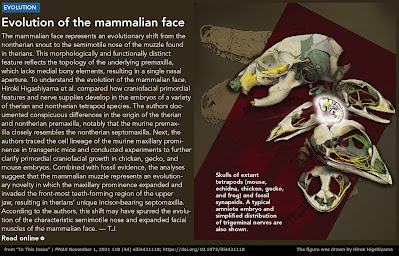 |
in Higashiyama, Koyabu, Hirasawa, ... et Kurihara, 2021. |
Significance:
The anatomical framework of the jaw has traditionally been thought to be highly conserved among vertebrates. However, here we show that the therian-unique face (muzzle) evolved via a drastic alteration of the common pattern of the tetrapod jaw. Through comparative morphological and developmental analyses, we demonstrated that the therian mammal’s premaxilla (rostral-most upper jawbone) is derived from the maxillary prominence of the mandibular arch. The developmental primordium that produces the premaxilla in nonmammalian tetrapods rarely contributes to the upper jaw in therian mammals but rather forms a motile nose. We propose that these previously unrecognized rearrangements allowed key innovations such as the highly sensitive tactile perception and olfactory function in mammalian evolution.
Abstract
The anterior end of the mammalian face is characteristically composed of a semimotile nose, not the upper jaw as in other tetrapods. Thus, the therian nose is covered ventrolaterally by the “premaxilla,” and the osteocranium possesses only a single nasal aperture because of the absence of medial bony elements. This stands in contrast to those in other tetrapods in whom the premaxilla covers the rostral terminus of the snout, providing a key to understanding the evolution of the mammalian face. Here, we show that the premaxilla in therian mammals (placentals and marsupials) is not entirely homologous to those in other amniotes; the therian premaxilla is a composite of the septomaxilla and the palatine remnant of the premaxilla of nontherian amniotes (including monotremes). By comparing topographical relationships of craniofacial primordia and nerve supplies in various tetrapod embryos, we found that the therian premaxilla is predominantly of the maxillary prominence origin and associated with mandibular arch. The rostral-most part of the upper jaw in nonmammalian tetrapods corresponds to the motile nose in therian mammals. During development, experimental inhibition of primordial growth demonstrated that the entire mammalian upper jaw mostly originates from the maxillary prominence, unlike other amniotes. Consistently, cell lineage tracing in transgenic mice revealed a mammalian-specific rostral growth of the maxillary prominence. We conclude that the mammalian-specific face, the muzzle, is an evolutionary novelty obtained by overriding ancestral developmental constraints to establish a novel topographical framework in craniofacial mesenchyme.
Keywords: evolution, craniofacial, skull, mammals
 |
| Evolutionary transitions of upper jaw bones in the fossil synapsids. |
Hiroki Higashiyama, Daisuke Koyabu, Tatsuya Hirasawa, Ingmar Werneburg, Shigeru Kuratani, and Hiroki Kurihara. 2021. Mammalian Face as An Evolutionary Novelty. PNAS. 118 (44); e2111876118. DOI: 10.1073/pnas.2111876118
